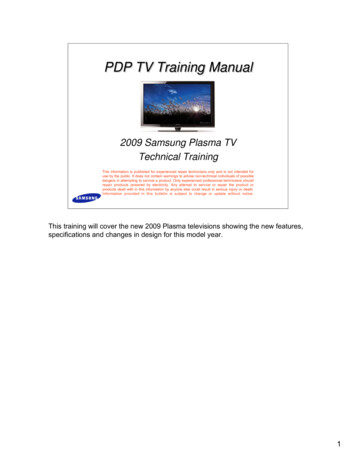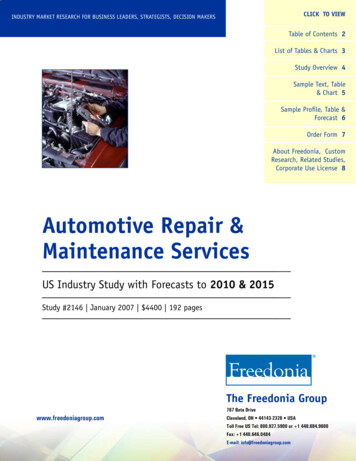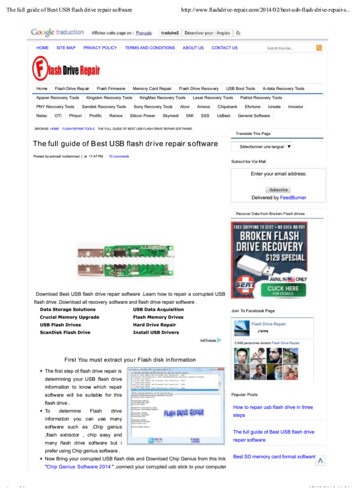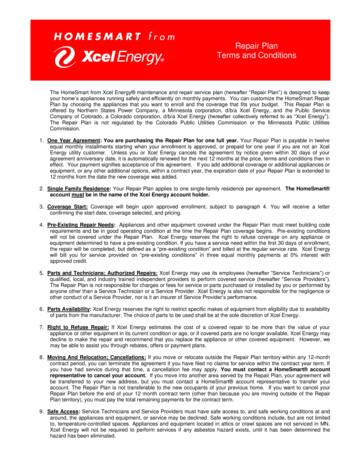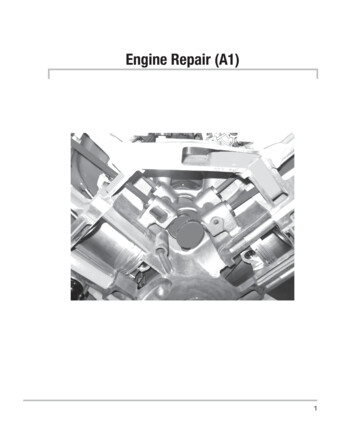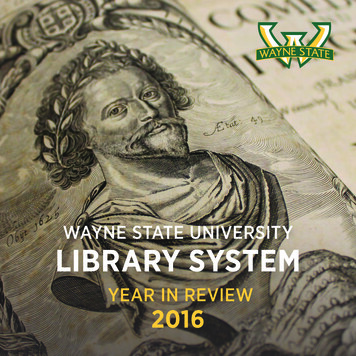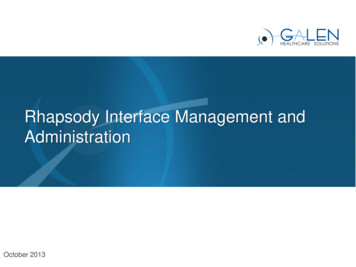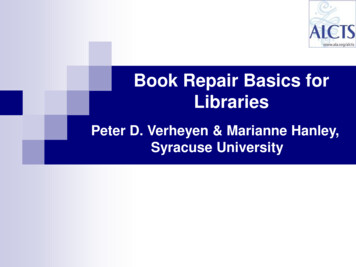
Transcription
Book Repair Basics forLibrariesPeter D. Verheyen & Marianne Hanley,Syracuse University
Upcoming Webinars Floating Collections, Dawn Peters,September 21st RDA and Cartographic Materials, Paige G.Andrew, September 28thHosted by ALCTSThe Association for Library Collections and Technical Services
Introductions Peter D. Verheyen, Head of Preservation andConservation Beganwith circulating collections repair whilework-study student at Johns Hopkins. Followedby binding and rare book conservation trainingand career. Marianne Hanley, Assistant Conservator Managescirculating collections rehousing andrepair unit, trains and supervises work-studystudents in repair, and is learning furtheraspects of conservation.3
Aims and scope of this presentation Familiarize viewers with different aspects of circulatingcollections book repair for school, public, and academiclibrary staff by showing: Basic descriptions of techniques, images, and videoThis presentation should not be construed as a how-to,hands-on workshop.Not aimed at treatment of special collections itemsResources for training will be provided at end.4
Circulating collections repair atSyracuse* Materials retained for long-term Weeding of collections very selectiveSelection criteria for repair Fromcirculation, proactively from heavily used areas ofthe collections Types treatments Simplerepairs (tip-ins, hinge tightening, ) Spine repairs (rebacking) Rebinding (sent to commercial bindery)* and many other research / academic libraries5
Public and school library context Materials not necessarily retained for long-term Circulated,weeded. Often minimal to enable a few more circulations Don’t repaired, circulated, repaired, circulated,address complex structural issuesMore likely to use self-adhesive products rather than wetadhesives Requireless infrastructure and training Quicker6
What we will cover ToolsAdhesives and other materialsSimple repairs Mending tears, tip-ins, hinge tighteningSpine repairs Simple“quick and dirty” Replacing missing spines Self adhesiveGlues 7
Tools BonefolderScissorsBox cutters and other knivesAwlStraight edgeCutting matBrushes8
Adhesives – Tape 1 NO duct or packing tape, rubber cement, gluesticks Images courtesy of Suzy Morgan9
Adhesives – Tape 2 Archival PVA, like Elmers but formulated to be moreflexibleFilmoplast and other “archival” tapes10
Simple repairs Page tears and tip-ins11
Mending tears Align parts of tearPrefer using Filmoplast P mending tapeas it is thinner and more flexible,making it less likely to cause paper totear adjacent to repair.Full width of roll not needed for mostrepairs Recommend cutting in halfbefore applyingReversible, to a point. Water soluble,but adhesives bonds tighter over time.Click to view video on YouTube12
Page tip-ins Used to reinsert loose pagesUsed when inserting replacement pagesRun very narrow bead of adhesive (PVA)along spine edge, insert into gutter andalign, apply pressure and let dry.If tipping-in replacement pages, makesure they are double-sided so as not toadd excessive bulk and split thetextblock. Larger numbers of pages canbe glued together first, then inserted intotextblock when dry.Click to view video on YouTube13
Hinge tightening14
Hinge tightening Loose or “shaken” hingesone of the leading causesof a further breakdown ofthe structure of a bookHinge tightening quickand easyMinimal tools Bonefolder, knitting needle, glueSee also: lClick to view video on YouTube15
Spine Repairs - Before16
Taped spine repairs I Using tape to reinforceweakening spine DONOT use on books beingpermanently retained Quick and dirty, do not holdup well with heavy useCan be damaging especiallyif needing to be removed Doesnot require specialadhesives Can be combined with hingetightening.17
Spine repairs II Self-adhesivebookcloth Goodfor simplerepairs whenboards still wellattached andbook spine solid. Buckram with glue Strongerclothand better whenboards aredetached Filmoplast T (at right) and Archival Products’C-cloth slit to custom widths. 10pt folder stockfor spine-stiffeners.18
Simple “reback” when boardsattached Self-adhesive bookcloth or buckram (to be glued)10 pt. folder stock for the spine stiffener19
Simple “reback” when boardsattachedClick to view video on YouTubeClick here for glued with buckram variant20
Full “reback” when boards detached Buckram and spine lining cloth (to be glued)10 pt. folder stock for the spine stiffenerSee book at right for exterior21
Full “reback” when boards detachedClick to view video on YouTube22
When to consult a conservator If the item is of historic or intrinsic value andsignificance. A well-intentioned repair can cause irreparable damage.If the repair is above your skill level. Know your limitationsTo find a conservator see the American Institute ofConservation.23
Appendix 1 – Selected workshops Check with your local/regional library consortia and your closest research librarypreservation department for hands-on workshops or other training opportunities in yourarea. Below are a few links to sample opportunities.Amigos California Preservation Program Book repair workshop supplies listBook repair workshopSee also InfoPeopleLyrasisNE Florida Information Network (NEFLIN)Northeast Document Conservation Center (NEDCC)Northwest Central (Pacific Northwest)24
Appendix 2 – Recommended videos Amigos DEMCO inc Book Repair - Spine Repair Part IBook Repair - Spine Repair Part IIAmerican University Library 25 videos – most use tapes for repairing headcaps, spines, tears SUNY New Paltz Library Mending a Book with Book Repair TapeHinge Tightening InstructionsHow To Repair a Book SpineUniversity of North Carolina Health Sciences Library Tip-ins25
Appendix 3 – Manuals and guidesonline Pamphlets Departmental Manuals Three Basic Book Repair Procedures – Instructions for three simple, non-invasive repairtechniques produced for ALA by Carole Dyal and Pete Merrill-OldhamGaylord Bros – Bookcraft Guide: Simple Techniques for the Maintenance & Repair of BooksAlaska State Library – Conservation Book RepairCornell University Library – Extensive series of manuals including basic circulating collectionsrepairDartmouth College Library - A Simple Book Repair ManualIndiana University Library – Online ManualListservs Book Arts-L – General book arts and bookbinding listserv that often has discussions on bindingstructure, adhesives, and materials.CoOL – Home of the Conservation Distlist. THE resource for conservation topics in all disciplinesPADG – Listserv of the ALA/ALCTS group formerly known as the Preservation AdministratorsDiscussion Group. Good place to ask about workshops 26
Appendix 4 – Selected vendors These vendors stock supplies for repairing circulating collections items, most with a largeselection of self-adhesive products like tapes BrodartDemcoGaylord Bros.KapcoTALAS: a great source of specialized toolsUniversity Products27
Thank youPlease feel free to contact us with questions atDepartment of Preservation and ts/preservationSee also our Resource Guide and YouTube ervation (Includes these slides and 8
Introductions Peter D. Verheyen, Head of Preservation and Conservation Began with circulating collections repair while work-study student at Johns Hopkins. Followed by binding and rare book conservation training and career. Marianne Hanley, Assistant Conservator Manages circulating collections rehousing and repair unit, trains and supervises work-study
